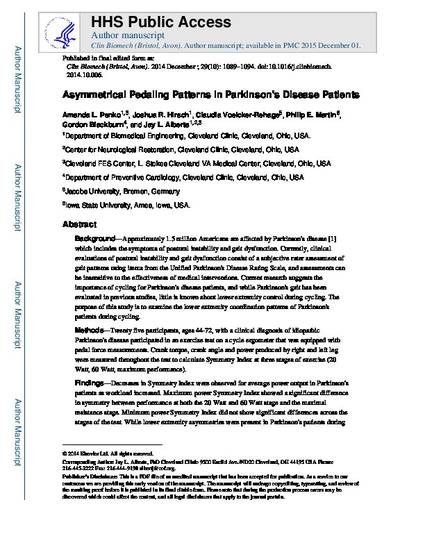
Approximately 1.5 million Americans are affected by Parkinson's disease (Deponti et al., 2013) which includes the symptoms of postural instability and gait dysfunction. Currently, clinical evaluations of postural instability and gait dysfunction consist of a subjective rater assessment of gait patterns using items from the Unified Parkinson's Disease Rating Scale, and assessments can be insensitive to the effectiveness of medical interventions. Current research suggests the importance of cycling for Parkinson's disease patients, and while Parkinson's gait has been evaluated in previous studies, little is known about lower extremity control during cycling. The purpose of this study is to examine the lower extremity coordination patterns of Parkinson's patients during cycling.Twenty five participants, ages 44-72, with a clinical diagnosis of idiopathic Parkinson's disease participated in an exercise test on a cycle ergometer that was equipped with pedal force measurements. Crank torque, crank angle and power produced by right and left leg were measured throughout the test to calculate Symmetry Index at three stages of exercise (20 W, 60 W, maximum performance).Decreases in Symmetry Index were observed for average power output in Parkinson's patients as workload increased. Maximum power Symmetry Index showed a significant difference in symmetry between performance at both the 20 W and 60 W stage and the maximal resistance stage. Minimum power Symmetry Index did not show significant differences across the stages of the test. While lower extremity asymmetries were present in Parkinson's patients during pedaling, these asymmetries did not correlate to postural instability and gait dysfunction Unified Parkinson's Disease Rating Scale scores.This pedaling analysis allows for a more sensitive measure of lower extremity function than the Unified Parkinson's Disease Rating Scale and may help to provide unique insight into current and future lower extremity function.
Available at: http://works.bepress.com/philip_martin/4/

This is a PDF file of an unedited manuscript that has been accepted for publication. Clinical Biomechanics (Bristol, Avon). 2014 December ; 29(10): 1089–1094. doi:10.1016/j.clinbiomech. 2014.10.006. As a service to our customers we are providing this early version of the manuscript. The manuscript will undergo copyediting, typesetting, and review of the resulting proof before it is published in its final citable form. Please note that during the production process errors may be discovered which could affect the content, and all legal disclaimers that apply to the journal pertain.